 W
WJohn Brown's raid on Harpers Ferry was an effort by abolitionist John Brown, from October 16 to 18, 1859, to initiate a slave revolt in Southern states by taking over the United States arsenal at Harpers Ferry, Virginia. It has been called the dress rehearsal for, or Tragic Prelude to, the Civil War.
 W
WThe Allstadt House and Ordinary was built about 1790 on land owned by the Lee family near Harpers Ferry, West Virginia, including Phillip Ludwell Lee, Richard Bland Lee and Henry Lee III. The house at the crossroads was sold to the Jacob Allstadt family of Berks County, Pennsylvania in 1811. Allstadt operated an ordinary in the house, and a tollgate on the Harpers Ferry-Charles Town Turnpike, while he resided farther down the road in a stone house. The house was enlarged by the Allstadts c. 1830. The house remained in the family until the death of John Thomas Allstadt in 1923, the last survivor of John Brown's Raid.
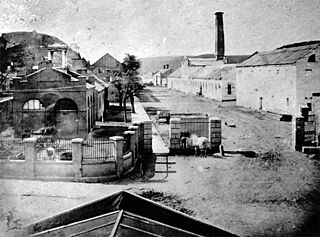 W
WThe Harpers Ferry Armory, more formally known as the United States Armory and Arsenal at Harpers Ferry, was the second federal armory created by the United States government. It was located in Harpers Ferry, Virginia. It was both an arsenal, manufacturing firearms, and an armory, a storehouse for firearms. Along with the Springfield Armory, it was instrumental in the development of machining techniques to make interchangeable parts of precisely the same dimensions.
 W
W"John Brown's Body" is a United States marching song about the abolitionist John Brown. The song was popular in the Union during the American Civil War. The tune arose out of the folk hymn tradition of the American camp meeting movement of the late 18th and early 19th century. According to an 1889 account, the original John Brown lyrics were a collective effort by a group of Union soldiers who were referring both to the famous John Brown and also, humorously, to a Sergeant John Brown of their own battalion. Various other authors have published additional verses or claimed credit for originating the John Brown lyrics and tune.
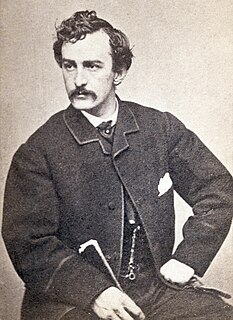 W
WJohn Wilkes Booth was an American stage actor who assassinated President Abraham Lincoln at Ford's Theatre in Washington, D.C., on April 14, 1865. A member of the prominent 19th-century Booth theatrical family from Maryland, he was a noted actor who was also a Confederate sympathizer; denouncing President Lincoln, he lamented the recent abolition of slavery in the United States.
 W
WJohn Brown was an American abolitionist leader. First reaching national prominence for his radical abolitionism and fighting in Bleeding Kansas, he was eventually captured and executed for a failed incitement of a slave rebellion at Harpers Ferry preceding the American Civil War. A man of strong religious convictions, Brown believed he was "an instrument of God", raised up to strike the death blow to American slavery, a "sacred obligation". Brown was the leading exponent of violence in the American abolitionist movement: he believed that violence was necessary to end American slavery, since decades of peaceful efforts had failed. Brown said repeatedly that in working to free the enslaved he was following the Golden Rule, as well as the U.S. Declaration of Independence, which states that "all men are created equal".
 W
WCloudsplitter is a 1998 historical novel by Russell Banks relating the story of abolitionist John Brown.
 W
WJohn E.P. Daingerfield was Acting Paymaster at the Harpers Ferry Armory at the time of John Brown's 1859 Raid; he was taken hostage but not injured.
 W
WJohn Brown's Fort was originally constructed in 1848 for use as a guard and fire engine house by the federal Harpers Ferry Armory in Harpers Ferry, Virginia. An 1848 military report described the building as "An engine and guard-house 35 1/2 x 24 feet, one story brick, covered with slate, and having copper gutters and down spouts…"
 W
WIsrael Greene was a member of the United States Marine Corps and the leader of the company of Marines that captured John Brown during his raid on Harpers Ferry. He later left the USMC and served as an officer in the Confederate States Marine Corps during the American Civil War.
 W
WHarpers Ferry, population 286 at the 2010 census, is a historic town in Jefferson County, West Virginia, United States, in the lower Shenandoah Valley. It is situated at the confluence of the Potomac and Shenandoah rivers, where the U.S. states of Maryland, Virginia, and West Virginia meet. It is the easternmost town in West Virginia and during the Civil War was the northernmost point of Confederate-controlled territory. It has been called, speaking of the Civil War, "the best strategic point in the whole South".
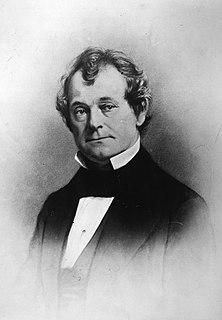 W
WAndrew H. Hunter was a Virginia lawyer, slaveholder and politician who served in both houses of the Virginia General Assembly. He was the Commonwealth's attorney (prosecutor) for Jefferson County, Virginia, who prosecuted John Brown for the raid on Harpers Ferry.
 W
WThe Jefferson County Courthouse is a historic building in Charles Town, West Virginia, USA. The building is historically notable as the site of two trials for treason: that of John Brown in 1859, and those of unionizing coal miners from Mingo County, West Virginia, a consequence of the Battle of Blair Mountain, whose trials were moved from the southern part of the state in 1922 as a result of a change of venue.
 W
WJohn Brown's Body (1928) is an epic American poem written by Stephen Vincent Benét. Its title references the radical abolitionist John Brown, who raided the federal armory at Harpers Ferry in Virginia in October 1859. He was captured and hanged later that year. Benét's poem covers the history of the American Civil War. It won the Pulitzer Prize for Poetry in 1929. It was written while Benét lived in Paris after receiving a Guggenheim Fellowship in 1926.
 W
WWhat his first biographer, James Redpath, called John Brown's last speech was delivered on November 2, 1859, at his sentencing, in a packed courtroom of whites in Charles Town, Virginia, after his conviction for murder, treason against the Commonwealth of Virginia, and inciting a slave insurrection. According to Ralph Waldo Emerson, this speech's only equal in American oratory is the Gettysburg Address.
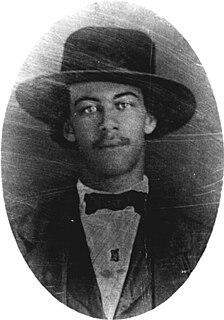 W
WLewis Sheridan Leary, an African-American harnessmaker from Oberlin, Ohio, joined John Brown's raid on Harpers Ferry, where he was killed. He was the first husband of Mary Patterson. By her second marriage to Charles Henry Langston, she became the future maternal grandmother of poet Langston Hughes.
 W
WJames Murray Mason, a grandson of George Mason, was a lawyer, slaveholder, and politician. He served as senator from Virginia, having previously represented Frederick County, Virginia, in the Virginia House of Delegates.
 W
WHarpers Ferry National Historical Park, originally Harpers Ferry National Monument, is located at the confluence of the Potomac and Shenandoah rivers in and around Harpers Ferry, West Virginia. The park includes the historic center of Harpers Ferry, notable as a key 19th-century industrial area and as the scene of John Brown's failed abolitionist uprising. It contains the most visited historic site in the state of West Virginia, John Brown's Fort.
 W
WRichard Parker was a nineteenth-century politician, lawyer, and judge from Virginia.
 W
W"A Plea for Captain John Brown" is an essay by Henry David Thoreau. It is based on a speech Thoreau first delivered to an audience at Concord, Massachusetts, on October 30, 1859, two weeks after John Brown's raid on Harpers Ferry, and repeated several times before Brown's execution on December 2, 1859. It was later published as a part of Echoes of Harper's Ferry in 1860.
 W
WRichard Realf was a poet who lived in many places throughout the United States, and whose work was informed by these travels. An obituary called him "a singularly unhappy man".
 W
WJames Redpath was an American journalist and anti-slavery activist.
 W
WRemarks After the Hanging of John Brown was a speech given by Henry David Thoreau on December 2, 1859, the day of John Brown's execution. Thoreau gave a few brief remarks of his own, read poetry by Sir Walter Raleigh, William Collins, Friedrich Schiller, William Wordsworth, Alfred Tennyson, George Chapman, and Henry Wotton, and then quoted from his own translation of Tacitus.
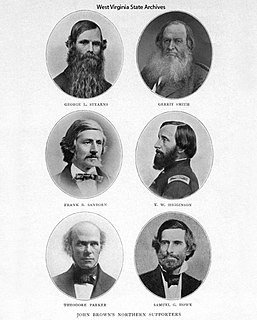 W
WThe so-called Secret Six, or the Secret Committee of Six, were a group of men who secretly funded the 1859 raid on Harper's Ferry by abolitionist John Brown. Sometimes described as "wealthy," this was true of only two. The other four were in positions of influence, and could, therefore, encourage others to contribute to "the cause."
 W
WGerrit Smith, also spelled Gerritt, was a leading American social reformer, abolitionist, politician, and philanthropist. Spouse to Ann Carroll Fitzhugh, Smith was a candidate for President of the United States in 1848, 1856, and 1860, but only served 18 months in the federal government—in Congress as a Free Soil Party Representative, in 1853–4.
 W
WLysander Spooner was an American individualist anarchist. He was also an abolitionist, entrepreneur, essayist, legal theorist, pamphletist, political philosopher, Unitarian, writer and a member of the First International.
 W
WGeorge Luther Stearns was an American industrialist and merchant in Medford, Massachusetts, as well as an abolitionist and a noted recruiter of black soldiers for the Union Army during the American Civil War.
 W
WGeorge Hume Steuart (1790–1867) was a United States general who fought during the War of 1812, and later joined the Confederate States of America during the Civil War. His military career began in 1814 when, as a captain, he raised a company of Maryland volunteers, leading them at both the Battle of Bladensberg and the Battle of North Point, where he was wounded. After the war he rose to become major general and commander-in-chief of the First Light Division, Maryland Militia.
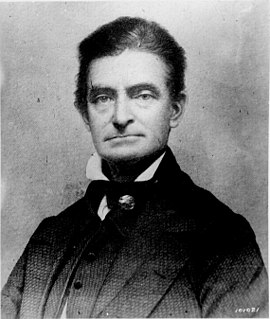 W
WVirginia v. John Brown was a criminal trial held in Charles Town, Virginia, in October of 1859. The abolitionist John Brown was quickly prosecuted for treason against the Commonwealth of Virginia, murder, and inciting a slave insurrection, all part of his raid on the United States federal arsenal at Harpers Ferry, Virginia. He was found guilty of all charges, sentenced to death, and was executed by hanging on December 2.
 W
WLewis William Washington was a great-grandnephew of President George Washington, a planter and slaveowner. He is most remembered today for his involuntary participation in John Brown's raid on Harpers Ferry, Virginia, in 1859. He was taken as hostage and some of his slaves were briefly freed. As he outranked the other hostages he was their unofficial spokesperson, and he testified in Brown's subsequent trial, and before the Senate committee investigating the raid.
 W
WWatson Brown was a son of the abolitionist John Brown and his second wife Mary Day, born in Franklin Mills, Ohio. He was married to Isabell [sic] Thompson Borwn, and they had a son Frederick W., who died of diphtheria at age 4, and is buried in North Elba.
 W
WHenry Alexander Wise was an American lawyer and politician from Virginia. He was a U.S. Representative and Governor of Virginia, and US Minister to Brazil. As Governor, he was much involved in the 1859 trial of abolitionist John Brown. During the American Civil War, he was a general in the Confederate States Army. He was the father of Richard Alsop Wise and John Sergeant Wise, who both served as U.S. Representatives.
 W
W W
W W
W W
W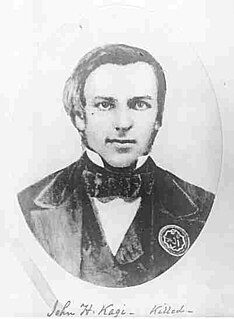 W
W W
W W
W